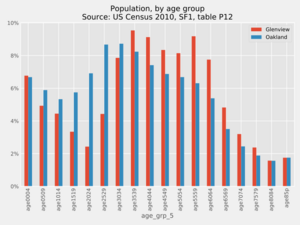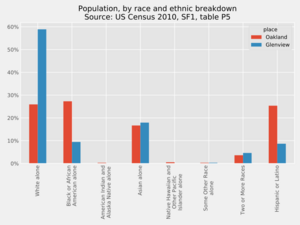Glenview, Oakland, California facts for kids
Quick facts for kids
Glenview
|
|
|---|---|
| Country | United States |
| State | California |
| County | Alameda |
| City | Oakland |
| Area | |
| • Total | 0.66 sq mi (1.7 km2) |
| • Land | 0.66 sq mi (1.7 km2) |
| • Water | 0 sq mi (0 km2) 0% |
| Elevation | 272 ft (83 m) |
| Population
(1 April 2010)
|
|
| • Total | 5,599 |
| • Density | 8,480/sq mi (3,275/km2) |
| ZIP code |
94602
|
Glenview is a friendly neighborhood in Oakland, California. Most of its homes are charming 2 or 3-bedroom houses called "craftsman bungalows," built in the early 1900s. It's located in the hills of Oakland, next to Dimond Park on one side and Park Boulevard on the other. Higher up, Glenview borders the Trestle Glen neighborhood and the city of Piedmont.
Park Boulevard is like the main street of Glenview. It has many shops and restaurants that stretch for several blocks. To the south, the neighborhood ends at MacArthur Boulevard and the I-580 freeway.
Glenview is a great place to walk around. It has a park, grocery stores, a library, and many restaurants close by. The website Walkscore.com even calls it "Very Walkable," meaning you can do most errands on foot. According to VisitOakland, Glenview feels like a quiet version of the Rockridge neighborhood, with nice restaurants and beautiful gardens. For longer trips, AC Transit offers local and city-to-city bus services, mainly from Park Boulevard and MacArthur Boulevard.
The neighborhood's school, Glenview Elementary School, was built in 1927. The original building was found to be unsafe in an earthquake and was taken down in 2017. Only its historic art deco front was saved. The school is being rebuilt and was expected to open after the winter break in 2019. Since the 2016-2017 school year, students have been going to classes at the Santa Fe campus in the Santa Fe neighborhood.
Who Lives in Glenview?
According to the 2010 Census, there were 2,576 households in Glenview. About 1,074 of these households rented their homes, while 1,502 owned them. The neighborhood had a total of 5,599 residents. Of these, 3,106 were female and 2,493 were male.
Compared to Oakland as a whole, Glenview had fewer teenagers and young adults. However, many people from the baby boomer generation (born between the mid-1940s and the mid-1960s) lived there in 2010. Glenview is about 0.66 square miles (1.7 square kilometers) in size. It has about 8,500 people per square mile, which is a bit more crowded than Oakland's average of 7,500.
Glenview is generally wealthier than Oakland as a whole. In 2016, the average household income in Glenview was $84,375, while for all of Oakland it was $57,778. For a long time, Glenview was a fairly affordable place to buy a home, especially for families starting out. It was also easy to travel from Glenview to San Francisco for work. However, like many areas in the East Bay, home prices in Glenview have gone up very quickly. In fact, in 2017, a real estate website called Redfin listed Glenview as one of the "10 Hottest Neighborhoods" in the country.
Glenview's Past
The Glenview neighborhood was first divided into lots for building homes around 1910. A company called Wickham Havens Inc. was the developer. At first, the areas were called Fourth Avenue Terrace (east of Park Boulevard) and Fourth Avenue Terrace Extension (west of Park Boulevard).
The company used maps as advertisements to attract buyers. They told people that the homes were "so close to the heart of Oakland that they should be classed as City, NOT suburban." They even said it was only a "fifteen minutes from the center of Oakland by car line." Buyers could get to the city using the Park Boulevard streetcar lines. Early maps also showed plans for a second, wider route for the Key System streetcar, which would run between Wellington Street and Hampel Street. This idea probably made the area more appealing to early buyers, but this streetcar extension was never actually built.
Most of the homes in Glenview were built by the mid-1930s. About seven out of every ten homes that exist today were built before 1939. In the mid-1930s, a report was written about the neighborhood's financial health for a government program called the Home Owners' Loan Corporation. This program later became known for a practice called "red-lining," which sometimes unfairly denied home loans to certain neighborhoods. However, local officials described Glenview positively in their report. They called it a "homogeneous district of semi-modern and modern homes and cottages." They also noted that it was "convenient to local transportation, excellent schools, and shopping district, in demand by better class people of moderate income."




